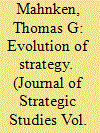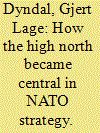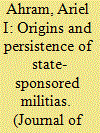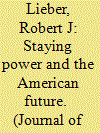|
|
|
Sort Order |
|
|
|
Items / Page
|
|
|
|
|
|
|
| Srl | Item |
| 1 |
ID:
106789


|
|
|
| 2 |
ID:
106794


|
|
|
|
|
| Publication |
2011.
|
| Summary/Abstract |
From the late 1970s and until the end of the Cold War, the 'High North' constituted a central theatre for military forces. Extensive NATO preparations were made, a solid infrastructure developed in northern Norway, and frequent and large-scale exercises were carried out. These developments, from the late 1970s, were much discussed by scholars and strategists. However, the change of perception, laying the foundation for the military build-up, had actually occurred a decade earlier, in the late 1960s. This change has not yet been given its rightful attention, partly because the relevant documents have only recently become available. This essay takes the chronology of events back into the 1960s and to NATO's secret discussions between the national Ministers of Defence and Chiefs of Staff. The most significant turning-points were the Flexible Response strategy of 1967; SACLANT's concern over increased Soviet naval activity and his 'Maritime Strategy' studies of 1965 and 1967; NATO's awakening to the Soviet SSBN threat in 1967; and the concept of 'External Reinforcement of the Flanks' of 1968 - finally followed by the 'Brosio Study' (named after the then NATO Secretary-General) of 1969. As a consequence of these developments NATO's 'tactical northern flank' was set to become an independent strategic theatre.
|
|
|
|
|
|
|
|
|
|
|
|
|
|
|
|
| 3 |
ID:
106793


|
|
|
|
|
| Publication |
2011.
|
| Summary/Abstract |
This article uses a sequential mixed method approach to examine the origins and persistence of paramilitaries and state-sponsored militias in the developing world. Combining comparative case studies of Southeast Asia and the Middle East with statistical analysis, it shows that revolutionary decolonization produces more decentralized and localized force structures, while direct inheritance of colonial armies leads to more conventional force structures. Subsequently, the level of competition within the regional system influences whether a state can persist in the use of paramilitaries or must transition to a more centralized, conventional force.
|
|
|
|
|
|
|
|
|
|
|
|
|
|
|
|
| 4 |
ID:
106795


|
|
|
|
|
| Publication |
2011.
|
| Summary/Abstract |
Several countries have used coercive diplomacy to dissuade sponsor-states from supporting non-state armed groups. This study argues that when a sponsor-state and a non-state armed group's common identity creates common aspirations and motives, coercive diplomacy towards the sponsor-state is unlikely to succeed in the long-term. To assess its efficacy, this research examines Turkey's strategy towards Syria in 1998 and in northern Iraq from 2007 onwards. Under the abovementioned conditions, it concludes that there has been no conclusive evidence for Turkey's assumption that its approach would succeed; therefore, it should utilise alternative strategies to coercive diplomacy.
|
|
|
|
|
|
|
|
|
|
|
|
|
|
|
|
| 5 |
ID:
106792


|
|
|
|
|
| Publication |
2011.
|
| Summary/Abstract |
Many scholars, strategists and pundits contend that the US is in decline. They argue that America's national capabilities are significantly eroding, and that with the rise of important regional powers, its primacy in world affairs is rapidly diminishing as well. Yet America continues to possess significant advantages in critical sectors such as economic size, technology, competitiveness, demography, force size, power projection, military technology, and in the societal capacity to innovate and adapt. This article argues that the nature of material problems has been overstated, and that the US should be able to withstand modest erosion in its relative strength for some time to come without losing its predominant status. Instead, where limits to American primacy do exist, they are as or more likely to be ideational as they are material. The problem inheres as much or more in elite and societal beliefs, policy choices, and political will, as in economic, technological or manpower limitations at home, or the rise of peer competitors abroad.
|
|
|
|
|
|
|
|
|
|
|
|
|
|
|
|
| 6 |
ID:
106791


|
|
|
| 7 |
ID:
106790


|
|
|
|
|
|
|
|